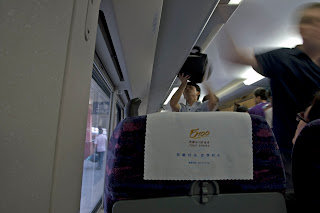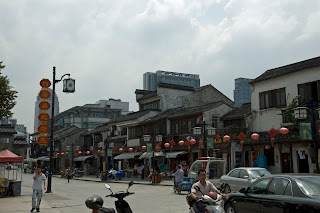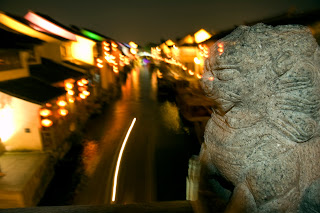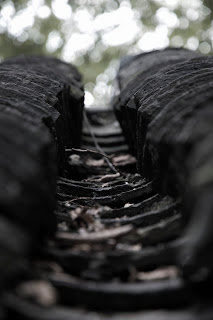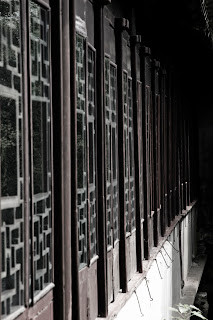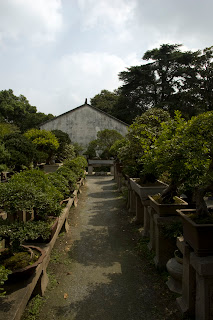Day 9 - Xi'an
View Larger Map
The lights came on automatically at 6 in the morning, and there was a mad dash to use the toilet for everyone in the train. They locked the bathrooms ten minutes before the train arrived at any station, so you had to time it right. We arrived in Xi'an a little late, and navigated our way through the train station. Xi'an is one of the oldest cities in China, and the only one with it's old city wall still intact. The city has around 8 million people, and they all seemed to be waiting for a taxi at the train station. Since we had a schedule to keep the guide made the executive decision to get a more expensive bus alternative. The salesman must have been really good when he said that he had two buses. Really it turned out to be two boxes on four wheels with a lawn mower engine hidden somewhere. In lieu of seats and seat belts there were benches that rivaled the adjustability of seats in any expensive minivan, given they weren't bolted to anything.

We stopped first at our YMCA accommodations. After cleaning up a bit we walked over to the old part of the town, making sure there was time to stop for a dumplings breakfast. Calling it the "old" part of town is a misnomer since it is now the main modern shopping area, where Walmart slums it with Prada. The old city wall encapsulates this part of town which sits next to the bell and drum towers in the middle of a giant round-about.
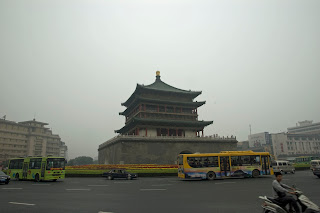
The wall in Xi'an has existed for thousands of years, but in it's current incarnation it is 'only' about 400 years old from the Ming Dynasty. A lot of the ancient parts of China that we see today are actually from the Ming dynasty, or repaired during then. On top of the wall we could rent bicycles to ride around the entire length of the wall on the top. About half way around I became the focus of a Chinese tourist's photos. I could see the camera pointed at me and then he waved, so I smiled and waved back. I could only imagine how I must have appeared to them - a hairy white man, too big for the bike with my knees coming close to hitting my chest, lumbering down the wall.



After the group split up, I went down to "paint" street. This was the artisan center of town, where you could buy everything from the paper and brushes to the finished product. Then I headed back past the bell and drum towers towards the Muslim Quarter. The towers were once used as timepieces - Bell for daytime, drum for night.
 The Muslim Quarter houses around 100,000 Muslims, a small percentage of the 8 million people but one of the largest in this part of China. I meandered my way through the street market. The colorful sites of dried fruit and nuts mixed with the intoxicating smells of Middle Eastern spices - cardamon, cinnamon, turmeric - made it difficult to resist the barbecuing meats on a stick, but I heeded the guide's advice not to eat anything but dried fruit from there. Later I walked down a side street where I understood his reasoning. Unidentified pieces of meat sat out on counters in the midday foggy heat; some sat on blocks of ice, others cooled only by a fan, and yet others cooled by some creative device that looked like a spinning pole with rags attached. Yum! Large organs (kidneys? liver?) sat being guarded by hoards of flies. I hurried past, avoiding the smell.
The Muslim Quarter houses around 100,000 Muslims, a small percentage of the 8 million people but one of the largest in this part of China. I meandered my way through the street market. The colorful sites of dried fruit and nuts mixed with the intoxicating smells of Middle Eastern spices - cardamon, cinnamon, turmeric - made it difficult to resist the barbecuing meats on a stick, but I heeded the guide's advice not to eat anything but dried fruit from there. Later I walked down a side street where I understood his reasoning. Unidentified pieces of meat sat out on counters in the midday foggy heat; some sat on blocks of ice, others cooled only by a fan, and yet others cooled by some creative device that looked like a spinning pole with rags attached. Yum! Large organs (kidneys? liver?) sat being guarded by hoards of flies. I hurried past, avoiding the smell.
 As I left, cars vied for a way to enter the narrow streets of the quarter. A hierarchical game of honking horns began, starting with the little moped, then a car, and finally, the clear winner, the load thunderous horn of the garbage truck.
As I left, cars vied for a way to enter the narrow streets of the quarter. A hierarchical game of honking horns began, starting with the little moped, then a car, and finally, the clear winner, the load thunderous horn of the garbage truck.It was the weekend in Xi'an, and it seemed that the entire city, once having found a taxi at the train station, moved to the shopping district. No one seemed to actually go into the stores, just on the sidewalk. Xi'an is also very popular amongst Chinese tourists, and given that holidays hadn't quite ended, the swarms of people probably were a mix of tourists and locals.
Xi'an at night


That night we went out to the Big Goose Pagoda. This is an ancient pagoda that has been modernized with it's own water fountain show synchronized with music.
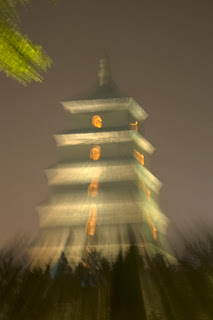

Day 10 - Terracotta Warriors
When I was young, not sure how old, the Denver Museum of Natural History held a traveling exhibition from China. It included many "wonderous things" as Carter might have put it. There were several of the Terracotta Warriors that I vividly remember, so perhaps it is the warriors more than anything that fuel my geographical imaginaries about China, a land of mystery and wonder. Even though I did see them before, nothing really prepared me for seeing where they sat forgotten for thousands of years till seven farm brothers decided to dig a water well. Even then it may have remained unknown if it had not been reported to an archaeologist (the brothers for their part content to ignore the find and continue with the well). The archaeologist kept relatively quiet on the matter, fearful of any remnants of the cultural revolution, himself being paraded around by zealous youths seeking to detach themselves from China's extensive history. Long gone, though, are the pastoral lands and dirt roads of when the warriors were discovered, made way for an expressway and massive complex complete with a market where those ex farmers can sell replicas of the army to the 10,000 daily visitors.
Pit 1 is to the left, pit 2 to the right, and pit 3 is not visible behind pit 2.

Our first stop was to a factory where they made those replicas, from small chess piece size to giant life size replicas. The local furniture store in Darwin actually carries two of these life size ones for only a few thousand dollars, but it was too late to return the one I ordered in China for the baby's room. The manufacture process is probably very close to how the originals were made. The bodies are actually all nearly the same, made from a plaster cast, headless and unarmed. The heads are a bit like a Mr. Potato Head doll; by using different noses, eyebrows, and facial hair, the artisans were able to create thousands of unique faces. The factory actually creates duplicates of existing statues rather than new ones. I couldn't resist getting a little copy, but couldn't find it's life size counterpart in situ.

Like so many ancient statues, that have survived the years, they were actually coated in a layer of paint. It's hard to imagine the white marble statues of Ancient Greece coated in bright blues and yellows, but they were. Same with the Terracotta Statues, and like it is difficult not to see marble as white it is difficult for us to see these statues covered in anything but mud. So you won't find any of the duplicates painted. They actually come out of the kiln black in color, and then they add dirt to the exterior for an "authentic" look.
Patiently awaiting their turn in the kiln.

Another 1/2 hour drive and we were at the entrance....the first entrance, then a cart to the compound.
A glimpse into my future tourist self.

Pit No. 1 is perhaps the most famous, with its rows of carefully restored soldiers standing at attention. I wasn't prepared for the size of the building, at least the size of an American Football stadium. The soldiers in this pit are primarily infantrymen, and were found not in the current state but in several pieces. Shortly after the First Emperor of China died, Qin, his tomb was raided for the real weapons the fake soldiers held. A fire was set, accidentally or on purpose, and the timbers holding the rammed earth roof collapsed crushing everything below.
Still many parts to be uncovered.

We were assigned a local guide for the day. While he did provide some of the facts above, most of them came from The Terracotta Army by John Man. The best parts of the book were the historical stories about the Emperor. The guide, as a matter of fact, was pretty useless, and calling him a salesman may have been more accurate. After Pit 1, he wasted a half hour of our time flipping through a book about the Terracotta Warriors describing the pictures. I kept thinking "Why are we sitting here when we could just go look at the actual bloody things?" Granted, not everything in the book is visible to visitors, and the reproductions are excellent, but the whole time it felt like they were doing everything in their power to stop us from actually visiting the different pits and more time trying to get us to spend money. I would have probably gladly bought the book (which I did not) had it been at the end of the tour after getting our fill of the actual army.
Next we were brought into the gift shop so we could purchase the book and get it signed by one of the few surviving farmers who discovered the warriors. You aren't allowed to photograph or speak to the farmer, and rumor has it the only characters he can write are his name. There was one story related by Man about the farmer which I found pretty amusing, but probably not true. Former President Clinton was apparently visiting the complex, and asked if he could meet one of the farmers. The officials decided to set up a quick photo shoot. The farmer of course could not speak a lick of English so the Chinese officials hastily taught him a few phrases. Clinton would say "Hello", the farmer would ask "How are you?" Clinton would then respond with "I'm fine," and the farmer would say "Me too." The big moment arrived, and the farmer gave his line, but only it came out sounding more like "Who are you?" Clinton responded to this by saying "I'm Hillary's husband." To which the farmer said "Me too."
Unfortunately there were no dignataries on our visit, but there was a 360 degree cinemascope feature film. Made, I think, before there was such a thing as dialogue and plot development.
"No Touching" Glass Guarding the Guard


Then it was to the museum, which was a very large monumental building with a very disturbing entrance, and a very small collection. But what it houses is a model in craftsmenship and restoration abilities. As part of the Emperor's tomb, he made sure that he would be able to get around in style in the afterlife like he used to when he was amongst the living, so he had miniature versions of his carriage and chariot guard made of bronze. One could easily have spent an hour finding every intricate detail on each of these two pieces, from the bridle and bit on the horse to the charioteer's quiver filled with exact miniature duplicates of arrows. Again, they were crushed by the roof collapsing, and beautifully restored.
This scares me.


My thirst for seeing the army and objects finally quenched, I headed back to Xi'an a happy man. It is amazing that only part of the tomb has actually been opened, and only few number of the estimated 10,000 terracotta statues have actually been uncovered, let alone the burial chamber of the Emperor himself. It was written by later generations that the burial chamber contained miniature versions of the rivers of China made of mercury. They recently did some tests and discovered the burial mound did contain higher levels of mercury than the surrounding area. Personally, I think the most remarkable thing is the amount of patience at the dig. I would have torn into the burial chamber long ago :).
We had a couple of hours in Xi'an to ourselves before catching a night train to Beijing, so I headed out to get some supplies. It's funny how exactly similar Walmart can be in every part of the world, yet have something very distinct such as the strong odor of durian throughout the store.
The waiting room at the train station...not sure what to make of this.

One more night train.

 For the second night train, we had bunks closer to one another. Except for Dan, who is in the very top bunk above a group of possibly Russian tourists who spent most of night drinking cheap wine and vodka. Dan looked a little green the next morning from the fumes and rocking. Next stop Beijing!
For the second night train, we had bunks closer to one another. Except for Dan, who is in the very top bunk above a group of possibly Russian tourists who spent most of night drinking cheap wine and vodka. Dan looked a little green the next morning from the fumes and rocking. Next stop Beijing!









